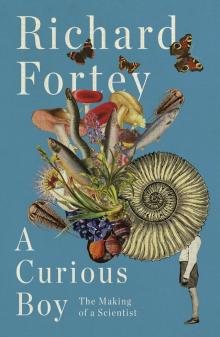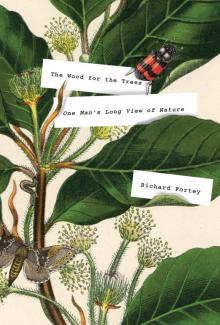- Home
- Richard Fortey
The Wood for the Trees
The Wood for the Trees Read online
ALSO BY RICHARD FORTEY
The Hidden Landscape: A Journey into the Geological Past
Life: A Natural History of the First Four Billion Years of Life on Earth
Trilobite! Eyewitness to Evolution
Fossils: The Key to the Past
Earth: An Intimate History
Dry Storeroom No. 1: The Secret Life of the Natural History Museum
Survivors: The Animals and Plants That Time Has Left Behind
Horseshoe Crabs and Velvet Worms
THIS IS A BORZOI BOOK
PUBLISHED BY ALFRED A. KNOPF
Copyright © 2016 by Richard Fortey
All rights reserved. Published in the United States by Alfred A. Knopf, a division of Penguin Random House LLC, New York. Originally published in hardcover in Great Britain by William Collins, an imprint of HarperCollins Publishers, London, in 2016.
www.aaknopf.com
Knopf, Borzoi Books and the colophon are registered trademarks of Penguin Random House LLC.
Library of Congress Cataloging-in-Publication Data
Names: Fortey, Richard A., author.
Title: The wood for the trees : one man’s long view of nature / Richard Fortey.
Description: First American edition. | New York : Alfred A. Knopf, 2016. |
Includes bibliographical references.
Identifiers: LCCN 2015048791 (print) | LCCN 2016032290 (ebook) |
ISBN 9781101875759 (hardcover) | ISBN 9781101875766 (ebook)
Subjects: LCSH: Old growth forests—England—Chiltern Hills. |
Phenology—England—Chiltern Hills. | Chiltern Hills
(England)—History.
Classification: LCC QH138.C54 F67 2016 (print) | LCC QH138.C54 (ebook) |
DDC 577.309425—dc23
LC record available at https://lccn.loc.gov/2015048791
Ebook ISBN 9781101875766
Cover images: (plant) Florilegius/Alamy Stock Photo; (beetle) by Bridgette James/Bridgeman Images; (moth) © Purix Verlag Volker Christen/Bridgeman Images; (caterpillar) Florilegius/Getty Images
Cover design by Kelly Blair
v4.1
a
For Eileen and Stuart Skeates
Contents
Cover
Also by Richard Fortey
Title Page
Copyright
Dedication
List of Illustrations
Map
1. April
2. May
3. June
4. July
5. August
6. September
7. October
8. November
9. December
10. January
11. February
12. March
Acknowledgements
Notes
Illustrations
Illustrations
Colour Plates
The interior of the wood in March. © Birgir Bohm
The same view in April. © Birgir Bohm
A rare white bluebell. © Jackie Fortey
The lesser celandine. © Jackie Fortey
A beech seedling sprouts from the woodland floor. © Jackie Fortey
Inconspicuous flowers of the holly tree in spring. © Rob Francis
Wild cherry in its vernal glory. © Jackie Fortey
Wild cherry flowers. © Jackie Fortey
Lonny van Ryswyck’s experiments with natural materials in the wood. Lonny van Ryswyck and Nadine Sterk, Atelier NL, Eindhoven, the Netherlands. Photo by Walter Kooken
Yellow bird’s nest (Monotropa). © Sally-Ann Spence
Painting of ghost orchid by Eleanor Vachell copied from an original by Ethel L. Baumgartner. In collections of Amgueddfa Cymru-National Museum Wales. NMW 49.29.6241
Pale Tussock Moth. © Andrew Padmore
The writer struggles with an identification handbook in the light of the moth trap, guided by Andrew Padmore. © Jackie Fortey
Blood Vein Moth. © Andrew Padmore
Purple Thorn Moth. © Andrew Padmore
Satin Beauty Moth. © Andrew Padmore
Speckled wood butterfly. © Andrew Padmore
Peacock butterfly. © Andrew Padmore
Silver-washed fritillary butterfly. © Andrew Padmore
Comma butterfly. © Andrew Padmore
Red kite. © Rob Francis
Brown long-eared bat. © Claire Andrews
Field vole. © Sally-Ann Spence
Hazel dormouse. © Danny Green
Hoard of late Iron Age coins found inside a hollow flint close to the wood. HCR6698 The Henley Hoard. © Ashmolean Museum, University of Oxford
Small truffles (Elaphomyces). © Jackie Fortey
A selection of snails from the wood. © Jackie Fortey
The cherry-picker lifting the writer up into the canopy of the beech trees. © Jackie Fortey
Large black terrestrial spider Coelotes terrestris. © P. R. Harvey
Slime mould (Lycogala epidendrum). © Jackie Fortey
Crab spider Diaea dorsata. © P. R. Harvey
A rare crane fly (Ctenophora). © Andrew Padmore
The view westwards across the Assendon Valley from Henley Park, with our wood near the skyline. © Rob Francis
Monument to the Knollys of Greys Court in Rotherfield Greys parish church. © Jackie Fortey
The manor house of Greys Court. © Jackie Fortey
The Stapleton family painted by Thomas Beach, 1789. © The Holburne Museum, Bath/Bridgeman Images
The pelargonium variety “Miss Stapleton.” © Jackie Fortey
1708 document recording the granting of rights to grub up the “Roots & Runts” of beech trees cleared just below our wood. Courtesy of the Oxford History Centre (catalogue ref. PAR209/13/9D/4), from the collection of the parish of Oxford St. Mary the Virgin
Magpie toadstool. © Jackie Fortey
Stinkhorn fungus (Phallus impudicus). © Jackie Fortey
Sulphur polypore. © Jackie Fortey
Ink caps growing on a rotten beech stump. © Jackie Fortey
Rhodotus palmatus. © Jackie Fortey
Red slug Arion rufus. © Jackie Fortey
Black dor beetle Anoplotropes. © Jackie Fortey
An uncommon beetle, Oedemera femoralis. © Andrew Padmore
Longhorn beetle Rutpela maculata. © Andrew Padmore
Sexton beetle Nicrophorus humator. © Andrew Padmore
Alistair Phillips turning a wild cherry-wood bowl from timber derived from one of our felled trees. © Jackie Fortey
Small-scale charcoal-burning. © Rebecca Fortey
A flint derived from the chalk at the Fair Mile. © Jackie Fortey
The author on a cherry branch. © Jackie Fortey
Henley from the Wargrave Road by Jan Siberechts (1698). Courtesy of the River and Rowing Museum, Henley-on-Thames
Wych elm leaf in autumn. © Rob Francis
Male wych elm flowers in early spring. © Jackie Fortey
The drawers of Philip Koomen’s cabinet. Photograph © Rob Francis
The Koomen collection cabinet back in the wood. Photograph © Rob Francis
Shield lichen (Parmelia). © Jackie Fortey
Bank haircap moss (Polytrichastrum). © Jackie Fortey
Text Illustrations
Location map of Grim’s Dyke Wood. © Leo Fortey
Half-timbered cottage in Assendon. © Rob Francis
Spring view of Lambridge Wood. © Rob Francis
Thin section of conglomerate pebble. © Jan Zalasiewicz
“Fiddlehead” male fern. © Jackie Fortey
Stacked beech trunks. © Jackie Fortey
Grey squirrel damage to a beech tree. © Jackie Fortey
Sedges. © Nina Krauzewicz<
br />
Aurochs, Les Eyzies, France. Photo © Jackie Fortey
Misericord, St. Mary’s church, Beverley, Yorkshire. Photo © David Ross, www.britainexpress.com
Detail of Richard Davis’s map of Oxfordshire, 1797. Courtesy Simmons & Sons, Estate Agents, Henley
Ash and cherry bark. © Jackie Fortey
Nettlebed brick kiln. © Jackie Fortey
Sale notice for clay and sand rights, Nettlebed. Henley Library, Local Studies Collection
Kneeler in St. Botolph’s church, Swyncombe. Photo © Jackie Fortey
Ancient entrances in Henley. © Jackie Fortey
The Chantry House, Henley-on-Thames. © Jackie Fortey
Eighteenth-century print of Greys Court. From an original drawing courtesy Bodleian Library, MS.Top. Oxon d.480, p. 181c
Oak and beech bark. © Jackie Fortey
The Fair Mile. From John Southern Burn, A History of Henley-on-Thames, in the County of Oxford (London: Longman & Co., 1861)
Fungus foray. © Jackie Fortey
Aranaeus spiderweb. © Jackie Fortey
Seventeenth-century soldier wearing a Montero. From Thomas Jenner, The Military Discipline wherein “is Martially Showne the order for Drilling the Musket and Pike” (London, 1642)
Charity boards in St. Helen’s church, Benson, Oxfordshire. Photo © Jackie Fortey
Winter frost. © Jackie Fortey
Engraving of Fawley Hall (now Fawley Court) by J. C. Varrall, from a drawing by John Preston Neale, in Views of the seats of noblemen and gentlemen in England, Wales, Scotland and Ireland, Second Series, Vol. III, 1826
Henley Bridge, 1820. Courtesy Hilary Fisher
Tollhouse at Bix. © Jackie Fortey
Poster for timber sale, 1864. Photo © Jackie Fortey
The “top dog” at a Herefordshire sawmill. Courtesy Museum of English Rural Life, University of Reading
“Bodgers” in Buckinghamshire. Image from the website www.swop.org.uk, reproduced with the permission of Wycombe Museum Trust
Chair legs and stretchers. Image from the website www.swop.org.uk, reproduced with the permission of High Wycombe Library
View of Henley Bridge. Print from a drawing by W. Tombleson, published in Eighty Picturesque Views on the Thames and Medway, c. 1834. Reading Borough Libraries, Local Studies Collection
Henley Regatta, 1896. Marsh Brothers
Winter scene in the wood. © Jackie Fortey
Winter branches. © Jackie Fortey
The centre of Henley in the early 1900s. Courtesy Hilary Fisher
Postcard of Henley Bridge. Collection of Richard Fortey
The “Tree of Descent.” Ernst Haeckel, Evolution of Man, 1874
Copepod crustacean Bryocamptus. © Charles Hussey
Location of the wood in the Chiltern Hills, with main roads and places. The old road to Wallingford is marked with x’s through Bix in the lower map, dashes in the upper one.
1
April
After a working life spent in a great museum, the time had come for me to escape into the open air. I spent years handling fossils of extinct animals; now, the inner naturalist needed to touch living animals and plants. My wife, Jackie, discovered the advertisement: a small piece of the Chiltern Hills up for sale. The proceeds from a television series proved exactly enough to purchase four acres of ancient beech-and-bluebell woodland, buried deeply inside a greater stretch of stately trees. The briefest of visits clinched the deal—exploring the wood simply felt like coming home. On 4 July 2011 “Grim’s Dyke Wood” became ours.
I began to keep a diary to record wildlife, and the look and feel of the woodland as it passed through diverse moods and changing seasons. I sat on one particular stump to make observations, which I wrote down in a small, leather-bound notebook. I was unconsciously compiling a biography of the wood—bio in the most exact sense, since animals and plants formed an important part of it. Before long, I saw that the story was as much about human history as it was about nature. For all its ancient lineage, the wood was shaped by human hand. I needed to explore the development of the English countryside, all the way from the Iron Age to the recent exploitation of woodland for beech furniture or tent pegs. I was moved by a compulsion to understand half-forgotten crafts and revive half-remembered words like “bodger,” “spile” and “bavin.” Plans were made to fell timber, to follow the journey from tree to furniture; to visit the canopy in a cherry-picker; to explore the archaeology of that ancient feature, Grim’s Dyke, that ran along one side of the plot. I wanted to see if the wood could yield food as well as inspiration.
My scientific soul reawakened as I sought to comprehend the ways that plants and animals collaborate to generate a rich ecology. I had to sample everything: mosses, lichens, grasses, insects and fungi. I investigated the natural history of beech, oak, ash, yew and all the other trees. I spent moonlit evenings trapping moths; daytime frolicking with nets to catch crane flies or lifting up rotten logs to understand decay. I poked and prodded and snuffled under brambles. I wanted to turn the appropriate bits of geology into tiles and glass. The wood became a route to understanding how the landscape is forever in a state of transition, for all that we think it unchanging. In short, the wood became a project.
Grim’s Dyke Wood is just a segment in the middle of more extensive ancient woodland, Lambridge Wood, lying in the southern part of the county of Oxfordshire. Splitting Lambridge into separate plots generated a profit for the previous owner, but also allowed people of modest means to own and care for their own small piece of living history. Our fellow “woodies”—as Jackie terms them—proved to include a well-known harpsichordist, a retired professor of business systems, a founder member of Genesis (the band, not the book), a virologist turned plant illustrator, ex-actors turned psychologists, and a woman of mystery. Our own patch is one of the smaller ones. All of the “woodies” have their own reasons for wanting to be among the trees—some desire simply to dream, some would rather like to turn a profit, others to explore sustainable resources. I believe I am the only naturalist. All the owners are there to prevent the wood from being felled or turned into housing. For the long history of Lambridge Wood tells us that our trees are less worked today than at any time in the past. This sad redundancy is no less part of its tale, as our wood is inevitably connected to the wider world of commerce and markets. The histories of my home town, Henley-on-Thames, a mile away, and the famous river on which it sits are bound into the narrative of the surrounding countryside. Ancient manors controlled the fate of woodlands for centuries. I have to imagine what the wood would have seen or heard as great events passed it by; who might have lurked under the trees, what poachers and vagabonds, poets or highwaymen.
Once the project was under way a curious thing happened. I wanted to make a collection. This may not sound particularly remarkable, but for somebody who had worked for decades with rank after rank of curated collections it was rejuvenation. Life among the stacks in the Natural History Museum in London had stifled my acquisitiveness, but now something was rekindled. I wanted to collect objects from the wood, not in the systematic way of a scientist, but with something of the random joy of a young boy. Perhaps I wanted to become that boy once again. Eighteenth-century gentlemen were wont to have cabinets of curiosities in which they displayed items that might have conversational or antiquarian interest. I wanted to have my own cabinet of curiosity. I would add items when my curiosity was piqued month by month: maybe a stone, a feather or a dried plant—nothing for the eighteenth-century gent. I believe that curiosity is a most important human instinct. Curiosity is the enemy of certainty, and certainty—particularly conviction that other people are different, or sinful, or irreligious—lies behind much of the conflict and genocide that disfigure human history. If I could issue one injunction to humankind it would be: “Be curious!” My collection will be a way of encapsulating the whole Grim’s Dyke Wood project: my New Curiosity Shop. And I already know that the last item to be curat
ed will be the leather-bound notebook.
The collection requires a cabinet to house it. Jackie and I plan to fell one of our cherry trees and convert it into a wonderful receptacle for the wood’s serendipitous treasures. We must discuss the work with Philip Koomen, a noted Chiltern furniture-maker devoted to using local materials. Philip’s workshop, Wheelers Barn, is in the remotest part of the Chiltern Hills, only about five miles from Grim’s Dyke Wood as the crow flies, but about fifteen as the ancient roads wind hither and thither. His studio is imbued with calm. Polished sections through trees hanging on the walls show the qualities of each variety: colour, texture, grain and age all combine to distinguish not just different tree species, but individual personalities. No two trees are identical. Some have burrs that section into turbulent swirls. Pale ash contrasts with rich walnut, and cherry with its warm tones is satisfactorily different from oak. This is a man who cares deeply about materials and believes in the genius loci—an integration of human and natural history that lends authenticity to a hand-made item. Philip’s handiwork from our own cherry tree will be a physical embodiment of our wood, but by housing the idiosyncratic collection picked up as the project develops, it will also contain the wood, as curated by this writer. It will be a cabinet of memories as much as objects. We haggle a little about design, but I know I shall rely on his judgement. I will have to be patient when I gather up the small things in the wood that take my fancy. It will be some time before the collection can live in its dedicated home.
This book could be thought of as another kind of collection. Extracts from my diary describe the wood through the seasons. I follow H. E. Bates’s wonderful book Through the Woods (1936) in beginning in the exuberant month of April rather than with the calendar year, and frigid January. But then, H. E. Bates himself inherited the same plan from the writer and illustrator Clare Leighton, whose intimate portrait of her own garden through the cycles of the seasons, Four Hedges,1 he much admired. My friends and colleagues come to sample and identify almost every jot and tittle of natural history that they can find. Natural history leads on to science, and the stories of grand estates, woodland skills and trades, and life along the River Thames. Human folly and natural catastrophes link the wood to a wider world beyond the trees. This complex collection explains why the wood is as it is today; its rich diversity of life is a concatenation of particular circumstances. I am trying to reason how the natural world came to be so varied, and my understanding is refracted through the lens of my own small patch. I am trying to see the wood for the trees.

 A Curious Boy
A Curious Boy Dry Storeroom No. 1
Dry Storeroom No. 1 The Wood for the Trees
The Wood for the Trees